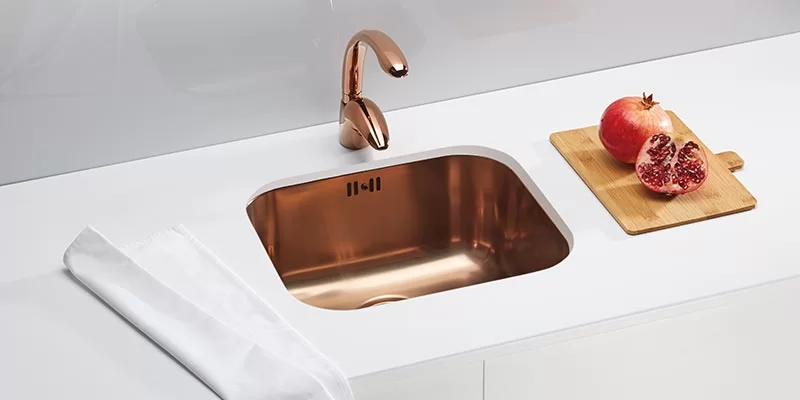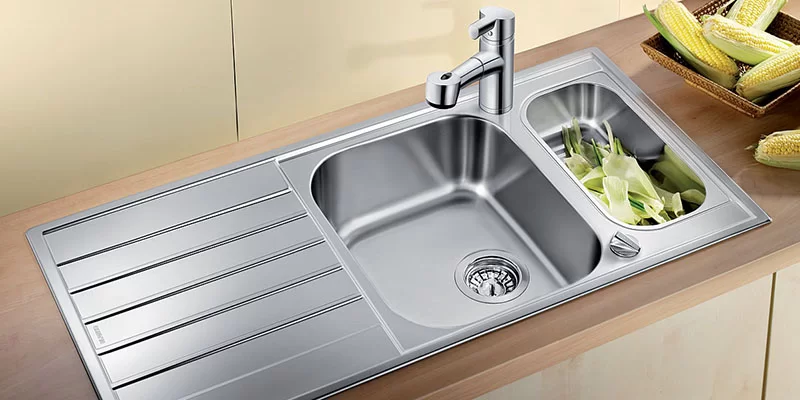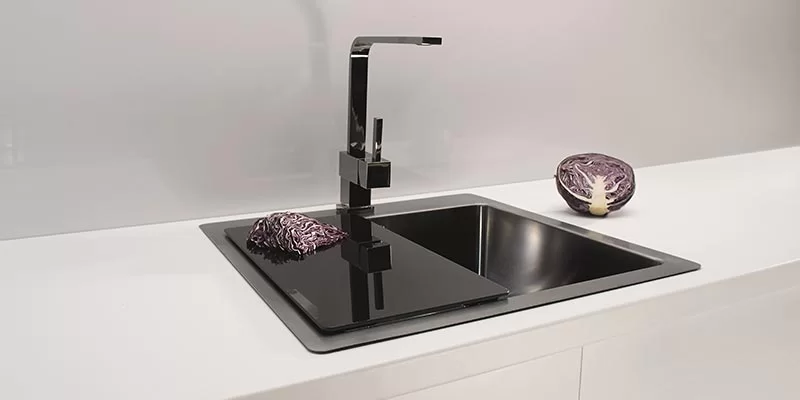The kitchen is the place where every day begins and ends. That is why it should be beautiful, comfortable and functional. And kitchen appliances largely determine the comfort of the entire room.
The comfort of the room is determined, among other things, by plumbing. A convenient and practical sink turns dishwashing from a routine duty into a pleasant process. But choosing plumbing can be quite tricky.
In particular, there are two types of this kitchen plumbing — mortise and overhead. They differ in price, design and placement. It’s just not clear what is better to place in your kitchen.
In this material, we will analyze which sink is better — mortise or invoice.
mortise sink

Mortise sink, as the name implies, cuts directly into the countertop. Therefore, it does not require special preliminary preparation of the kitchen set. Mortise plumbing can be installed in countertops made of any material — the question is money.
The fact is that preparing a countertop for the installation of mortise plumbing is an expensive task. In the kitchen set, it is required to make a hole that will correspond to the dimensions of the installed plumbing to the nearest millimeter. And if in some MDF tabletop this can be done with a jigsaw, then in a canvas made of artificial stone or other materials that are difficult to process, you will have to cut it using more professional and powerful equipment.
On the other hand, this placement of the sink leaves room for both design and user experience. For example, the sink may be flush with the countertop or slightly below it (“recessed”).
In addition, the shape and size of the bowl can be any. For example, in homes with large families, deep options that fit all the dishes after breakfast will be appreciated. And adherents of an unusual design can install not a rectangular bowl, but an oval or curved one.
Additionally, the bowl can be equipped with functional accessories — a cutting board, a grate for dishes, and so on. Mortise sink will make the kitchen more convenient for cooking and easy use.
But this has its own “price”. And it is not limited to the cost of hole preparation. Mortise sinks take up a lot of space in the cabinets themselves, “eating off” the usable space that could be used to store utensils or household chemicals.
In addition, if large-scale plumbing work is required in the kitchen, it will be necessary to dismantle both the plumbing and the headset in some cases.
So, let’s sum up.
Advantages
-
A variety of shapes, sizes, design solutions and functionality;
-
Strength and durability. This is due to the fact that mortise sinks are usually made of thicker metal than overhead ones;
-
Careful installation. The metal edging is tightly placed on the surface of the countertop, they are part of the overall kitchen ensemble. In addition, it can be tightly sealed, which will reduce the risk of leakage to zero;
-
High depth. Helps to accommodate a lot of dishes in the bowl or reduce the risk of splashes.
Flaws
-
You will need to prepare the countertop. Either you need to look for one that is already equipped with a hole of the right size, or cut it out in an already finished one. In the case of using countertops made of expensive or high-density materials, this can be expensive;
-
The hole must exactly match the dimensions of the bowl without “wings” — only a minimum tolerance is allowed, up to a few millimeters;
-
The high cost of the devices themselves.
The advantages of mortise sinks can also be attributed to the variety of materials. In most cases, sinks are made of stainless steel, but you can find acrylic, stone, copper, and even stone (including natural stone) on the market.
Overhead sink

An overhead sink involves installation in a special pedestal, in which either the necessary hole has already been cut, or the countertop is simply missing. The vast majority of these sinks are made in standard sizes for compatibility with a variety of kitchen sets. The most common dimensions of overhead sinks are 50×50 cm and 50×60 cm.
Overhead sink involves installation only in a special cabinet. It does not have a back wall, since it is required to connect the sink siphon to the sewer pipe. There are also no countertops in such a cabinet. The interior space of this piece of furniture can be used both for storing various kitchen utensils or household chemicals, and for installing just a trash can.
Overhead sinks themselves are compact and have medium functionality. The shallow depth of the sink does not allow loading it with dishes and does not protect well from splashes at high water pressure. The “wings” of the overhead sink — additional panels — also have a relatively small size. In most cases, all functional elements of the device are placed on an area of 50 × 50 centimeters.
On the other hand, overhead plumbing solutions are very easy to install and dismantle. When installing, even a specialist does not need to be called — the sink can be placed independently. The main thing is not to forget to seal the edges so that moisture does not leak into the cabinet.
Also they are low priced. The price tag starts from a few hundred rubles! And thanks to the standard dimensions, you won’t have to look for a cabinet for such a sink for a long time. In principle, you can build it yourself.
So, let’s sum up.
Advantages
-
Low price. On the market you can find models that cost from several of dollars!
-
You do not need to accurately select the dimensions of the nightstand. A small tolerance is allowed, within a few centimeters, since all these extra areas will be covered by wings or the edge of the shell;
-
Simple installation, which can be carried out independently;
-
Standard sizes, so it is not difficult to choose an overhead sink for an existing set.
Flaws
-
Boring, standard, monotonous design. In most cases, it is even “typical”. Because of this, fitting plumbing into an existing set can be either very difficult or impossible in principle;
-
It is required to seal the side edge very carefully;
-
Usually a relatively shallow depth, which is why you can’t pour a lot of dishes into the sink, and you can’t get rid of splashes throughout the kitchen.
-
Thin metal also means that the durability of overhead sinks leaves much to be desired. On average, they serve for several years, after which cracks, dents or other deformations may appear.
And another unpleasant drawback is the high level of noise, which occurs due to the contact of the water flow with a thin sheet of metal.
Which is better — mortise or overhead sink?

An inset sink is beautiful and convenient, but you have to pay for it. Literally. And the sink itself is expensive, and preparing the countertop for it is not cheap. Overheads will not require gutting a family piggy bank, but you can’t expect a beautiful design from them either. But the difference between the two types of kitchen plumbing is not limited to this.
|
|
|
|
|
|
Installed in a hole in the countertop, flush with the pedestal
|
Superimposed on top of the curbstone
|
|
|
Low, the contact area is small, and the shell depth is large
|
High. It is required to seal all contact edges
|
|
|
Requires high precision in hole preparation
|
Just put on top
|
|
|
In some cases, you will need to disassemble the entire headset
|
Just filmed
|
|
|
Both small and large options are available.
|
Most options are standard.
|
|
|
Unusual design sinks presented
|
Standard, standard. Original solutions are rare.
|
|
|
Big
|
Malaya
|
In general, mortise solutions are visually appealing, comfortable and practical — but expensive. And invoices are a budgetary standard option.

Добавить комментарий
Для отправки комментария вам необходимо авторизоваться.